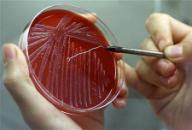...is about saying NO to the pharma-medico-industrial-baby complex and discovering the possibilities afforded by focusing on wellness of self and earth. Essays on parenting, race, life, and writing appear in The New York Times, Newsweek, The Washington Post, Slate. We're a Treehugger.com Favorite Green blog. FTC compliant disclosure: all items we test are complimentary samples. WINNER OF THE RICHARD MARGOLIS AWARD FOR SOCIAL JUSTICE REPORTING
Monday, June 29, 2009
Milk and Cancer and Monsanto and our manipulated News
http://www.youtube.com/watch?v=JL1pKlnhvg0
Did Toxic Chemical Cause Iraqi Vets Death and Disability?

From the AP:
Larry Roberta's every breath is a painful reminder of his time in Iraq. He can't walk a block without gasping for air. His chest hurts, his migraines sometimes persist for days and he needs pills to help him sleep.
James Gentry came home with rashes, ear troubles and a shortness of breath. Later, things got much worse: He developed lung cancer, which spread to his spine, ribs and one of his thighs; he must often use a cane, and no longer rides his beloved Harley.
David Moore's postwar life turned into a harrowing medical mystery: nosebleeds and labored breathing that made it impossible to work, much less speak. His desperate search for answers ended last year when he died of lung disease at age 42.
What these three men — one sick, one dying, one dead — had in common is they were National Guard soldiers on the same stretch of wind-swept desert in Iraq during the early months of the war in 2003.
These soldiers and hundreds of other Guard members from Indiana, Oregon and West Virginia were protecting workers hired by a subsidiary of the giant contractor, KBR Inc., to rebuild an Iraqi water treatment plant. The area, as it turned out, was contaminated with hexavalent chromium, a potent, sometimes deadly chemical linked to cancer and other devastating diseases.
read more here.
Wednesday, June 24, 2009
AP: VA in Penn. botched cancer treatments
This idea of planting radioactive seeds into people doesn't make sense to me, in that what keeps you from irradiating your loved ones, pets, etc? Strange to me how they are prosecuting parents whose children refuse cancer treatment. I think for some people, it would have been better to say no to this one (the Johns Hopkins-degreed doctor accidentally put the seeds in people's bladders, rectums, etc. Oops!) because even after the horrific mistakes were found, what did they do? Covered it up. It's also unclear if this doc is still practicing or not. Yikes!
From the AP:
PHILADELPHIA – Ninety-two veterans were given incorrect radiation doses in a common surgical procedure to treat prostate cancer during a six-year period at the Veterans Affairs Medical Center in Philadelphia, according to newspaper reports Sunday.
A hospital team that performed the procedure botched it on 92 of 116 occasions and continued the treatment for a year even though monitoring equipment was broken, The New York Times said. The Philadelphia Inquirer said treatment errors occurred in 92 of 114 cases.
The cases involved brachytherapy, in which implanted radioactive seeds are used to kill cancer cells. Most veterans got significantly less than the prescribed dose while others received excessive radiation to nearby tissue and organs.
Monday, June 22, 2009
Stand and Deliver? Upright Labor Positions Reduce Pain, Speed Birth
------------------------
Newswise — Women who walk, sit, kneel or otherwise avoid lying in bed during early labor can shorten the first stage of labor by about an hour, according to a new Cochrane evidence review. Women who labored out of bed during the early stages were also 17 percent less likely to seek pain relief through epidural analgesia, the review found.
“This shortens labor by about an hour and, for a lot of women, an hour would be really important,” said Teri Stone-Godena, director of midwifery at the Yale School of Nursing, who had no affiliation with the review.
Fortunately, the review did not find any differences in birth outcomes for mothers or babies due to labor position. There were no differences in terms of interventions like birth by Caesarian section. “I think this means that women can be reassured that any position that they want to get into is OK,” Stone-Godena said.
Overall, the review included 21 studies, examining 3,706 births.
It appears in the latest issue of The Cochrane Library, which is a publication of The Cochrane Collaboration, an international organization that evaluates medical research. Systematic reviews draw evidence-based conclusions about medical practice after considering both the content and quality of existing medical trials on a topic.
So why would staying out of bed shorten labor and reduce pain?
“Women who are upright and mobile are able to change their positions more easily,” said Annemarie Lawrence, lead review author and a research midwife at the Institute of Women’s and Children’s Health at Townsville Hospital in Queensland, Australia.
“The ability to change positions, to utilize a wider variety of positions, and try other options, such as hot showers, birthing balls and beanbag supports, may help reduce overall pain and give women a greater sense of control over the progress of their labor,” she said.
Friday, June 19, 2009
Antibiotics Kill off Benficial Bacteria

Antibiotics are one of modern medicine's greatest inventions, but have you ever thought of how scray the idea of something being anti-biotic? Anti living things? We are actually made up of bacteria, and they serve an important function, esp. in our guts where they synthesize and create vitamins, protect us against invaders such as bad bacteria and yeasts, and who know what else.
Much antibiotic use can actually be avoided and they are often prescribed erroneously; we had a caes of pinkeye in the house for which the doctor did NOT bother to culture to see if it was viral (where antibiotics wouldn't work) or bacterial. I used breast milk on me and the kid, my husband took the antibiotics. Guess whose cleared up in 24 hours and who had a five day gross infection.
If you HAVE to take antibiotics, e.g., for Lyme disease, I'd suggest stocking up on the kimchi and/or acidophilus supplements:
--------
Newswise — It’s common knowledge that a protective navy of bacteria normally floats in our intestinal tracts. Antibiotics at least temporarily disturb the normal balance. But it’s unclear which antibiotics are the most disruptive, and if the full array of “good bacteria” return promptly or remain altered for some time.
In studies in mice, University of Michigan scientists have shown for the first time that two different types of antibiotics can cause moderate to wide-ranging changes in the ranks of these helpful guardians in the gut. In the case of one of the antibiotics, the armada of “good bacteria” did not recover its former diversity even many weeks after a course of antibiotics was over.
The findings could eventually lead to better choices of antibiotics to minimize side effects of diarrhea, especially in vulnerable patients. They could also aid in understanding and treating inflammatory bowel disease, which affects an estimated 500,000 to 1 million Americans, and Clostridium difficile, a growing and serious infection problem for hospitals.
Normally, a set of thousands of different kinds of microbes lives in the gut – a distinctive mix for each person, and thought to be passed on from mother to baby. The microbes, including many different bacteria, aid digestion and nutrition, appear to help maintain a healthy immune system, and keep order when harmful microbes invade.
“Biodiversity is a well-known concept in the health of the world’s continents and oceans. Diversity is probably important in the gut microsystem as well,” says Vincent B. Young, M.D., Ph.D., senior author of the study, which appears in the June issue of Infection and Immunity.
The study results suggest that unless medical research discovers how to protect or revitalize the gut microbial community, “we may be doing long-term damage to our close friends,” says Young, assistant professor in the departments of internal medicine and microbiology and immunology at the U-M Medical School.
Tuesday, June 16, 2009
Teen correctly self diagnoses disease Doctors Missed
click here.
Monday, June 15, 2009
Food Inc., a look at Factory and Science Fiction Farming
| The Colbert Report | Mon - Thurs 11:30pm / 10:30c | |||
| Eric Schlosser | ||||
| www.colbertnation.com | ||||
| ||||
Thursday, June 11, 2009
Warning on Bacterial Contamination in Hand Sanitizers: FDA Warns Consumers
 Yo, keep it simple and try castile soap (like Dr. Bronner's, that you can buy in bulk concentrate that you dilute) and water. The soap makes the germs slide off, no need for an all-out assault to KILL them. Blech.
Yo, keep it simple and try castile soap (like Dr. Bronner's, that you can buy in bulk concentrate that you dilute) and water. The soap makes the germs slide off, no need for an all-out assault to KILL them. Blech.From the Huffington post:
---------
The FDA has warned consumers not to use Clarcon skin products. From the release:
Risk of bacterial contamination has led the Food and Drug Administration (FDA) to warn consumers to not use any products made by Clarcon Biological Chemistry Laboratory Inc.The Roy, Utah, firm voluntarily recalled some skin sanitizers and skin protectants sold under a variety of brand names after a recent FDA inspection found that the products contained high levels of disease-causing bacteria.
What products are consumers being warned not to use?
Consumers should not use any Clarcon products. Examples of these products include
• Citrushield Lotion
• Dermasentials DermaBarrier
• Dermassentials by Clarcon Antimicrobial Hand Sanitizer
Wednesday, June 10, 2009
Going to work sick increases changes of more absenteeism
From Newswise, the journalists'-only site:
--------------------------------------------------------
Newswise — Employees who often go to work despite feeling sick have higher rates of future work absences due to illness, according to a study in the June Journal of Occupational and Environmental Medicine, official publication of the American College of Occupational and Environmental Medicine (ACOEM).
The findings raise the possibility that measures attempting to decrease work absences could inadvertently have the opposite effect, if they encourage workers to come to work when sick.
Led by Gunnar Bergström, Ph.D., of Karolinska Institutet, Stockholm, the researchers evaluated whether going to work despite illness—called "sickness presenteeism"—affects future sickness absenteeism. The study included two groups of workers: about 3,750 public sector employees, mainly female; and 2,500 private-sector employees, mainly male.
Workers with more days going to work sick also had more days absent because of illness. In the first year of the study, 19 percent of public sector workers and 13 percent of private sector workers had more than five sickness presenteeism days. For these workers, the risk of having more than 30 days of sickness absenteeism the following year was 40 to 50 percent higher, after adjustment for other factors.
Recent studies have shown that sickness presenteeism is common—most employees say they go to work sick at least sometimes. Poor health is one likely risk factor for sickness presenteeism, but other job-related and personal factors could also play a role.
The new study suggests that employees with a lot of sickness presenteeism days also have more sickness absenteeism days. This may indicate the health-promoting aspects of taking sick leave when appropriate, as shown by previous studies.
Monday, June 08, 2009
Lifestyle Changes can Help Fibroids and Endometriosis
(NaturalNews) The incidence of fibroids and endometriosis are nearly epidemic in the USA. More than a half million American women have hysterectomies every year due to problems associated with fibroids and endometriosis. It is estimated that around 40% of American women 35 and older have fibroids and 10 to 20 percent of American women of childbearing age have endometriosis. Fortunately, woman can find relief from these health problems by implementing some lifestyle changes.
What is Endometriosis?
Endometriosis is a common gynecological condition which can affect up to 15% of all women. Half of all women with endometriosis will be infertile. It is a condition where the lining of the womb implants and grows outside the womb itself. It can grow in the Fallopian tubes, pelvis, bowel bladder and even the nasal passages. The tissue bleeds every time there is a period, but with endometriosis the blood has no outlet and becomes trapped in the tissue causing pain, inflammation, cysts and scar tissue. It appears endometriosis is sensitive to oestrogen, so high oestrogen levels are linked to endometriosis. Common symptoms are pain during periods, painful sex (60% of all cases), heavy or irregular periods, back pain, nausea, fatigue, GI problems and infertility.
What are Fibroids?
Fibroids are non-cancerous growths in or on the muscular wall of womb and affect about 20% of women over age of 30. Symptoms are mainly heavy periods - due to the surface of the womb being bigger, but there is no pain. Sometimes women experience frequent urination, constipation and even back ache; for some there is a risk of anemia and infertility.
Risk Factors Associated with Endometriosis and Fibroids
*Excess Levels of Estrogen / Deficient Progesterone: Excess estrogen causes abnormal tissue growth and is a direct cause of both fibroids and endometriosis for many women.
*X-Rays: Any amount of radiation may increase the risk of fibroids. Many women actually develop these problems months after a mammogram.
*Too Much Caffeine: A 2001 study published in Fertility and Sterility revealed that women who consume 500 milligrams of caffeine daily, which is the equivalent of 4-5 cups of coffee, produce 70% more estrogen in the follicular phase of the menstrual cycle than women who consume less than 1 cup of coffee.
*Meat: Research published in Obstetrics and Gynecology discovered that eating red meat doubles the risk of developing uterine fibroids. This is most likely due to the hormone injections and antibiotics given to conventional animals.
*Oral Contraceptives: Statistics show that a large percentage of women who have these issues have taken the pill. Oral contraceptives can also aggravate fibroid problems and endometriosis for susceptible women.
Lifestyle Changes that can Help Endometriosis and Fibromyalgia
*Fiber - Increase the amount of fibrous foods in the diet to balance estrogens
*Lose Weight - Being obese increases the number of fat cells in the body, which produces more oestrogen increasing hormone levels.
*Stress - stress can cause women to stop ovulating and hormonal issues.
*Avoid alcohol - It is the job of the liver to break up oestrogen levels and excrete them, so excess alcohol is a burden to the liver
*Avoid Sugar and simple carbohydrates such as white bread - These foods cause inflammation, pain and swelling.
*Avoiding smoking - this depletes micro-nutrients required for healthy hormone balance and the immune system.
*Essential Fats - EFAs help to metabolize hard, clogging saturated fats that contribute to fibroid growths. EFAs also help maintain hormone balance and reduce inflammation- important.
*Cruciferous veggies - These vegetables include broccoli, cauliflower, cabbage and Brussels sprouts and contain a natural antioxidant with powerful anti-tumor activity called Indole 3 carbinole. This improves estrogen metabolism and the body's ability to eliminate excess estrogen.
Tuesday, June 02, 2009
Cancer Research and conflicts of interest...
From Newswise, the journalists'-only site:
Newswise — Nearly one-third of cancer research published in high-impact journals disclosed a conflict of interest, according to a new study from researchers at the University of Michigan Comprehensive Cancer Center.
The most frequent type of conflict was industry funding of the study, which was seen in 17 percent of papers. Twelve percent of papers had a study author who was an industry employee. Randomized trials with reported conflicts of interest were more likely to have positive findings.
“Given the frequency we observed for conflicts of interest and the fact that conflicts were associated with study outcomes, I would suggest that merely disclosing conflicts is probably not enough. It’s becoming increasingly clear that we need to look more at how we can disentangle cancer research from industry ties,” says study author Reshma Jagsi, M.D., D.Phil., assistant professor of radiation oncology at the U-M Medical School.
The researchers looked at 1,534 cancer research studies published in prominent journals. Results of this current study appear online in the journal Cancer.
“A serious concern is individuals with conflicts of interest will either consciously or unconsciously be biased in their analyses. As researchers, we have an obligation to treat the data objectively and in an unbiased fashion. There may be some relationships that compromise a researcher’s ability to do that,” Jagsi says.
For example, she says, researchers might design industry-funded studies in a way that’s more likely to produce favorable results. They might also be more likely to publish positive outcomes than negative outcomes.
Monday, June 01, 2009
Female Hormones Replacement may make Lung Cancer more Fatal
Hormone users who developed lung cancer were 60 percent more likely to die from the disease as women who weren't taking hormones, according to results reported Saturday.
The new findings mean that smokers should stop taking hormones, and those who have not yet started hormones should give it careful thought, said Dr. Rowan Chlebowski of Harbor-UCLA Medical Center in Los Angeles. He led the analysis and presented results at a meeting of the oncology society in Florida.